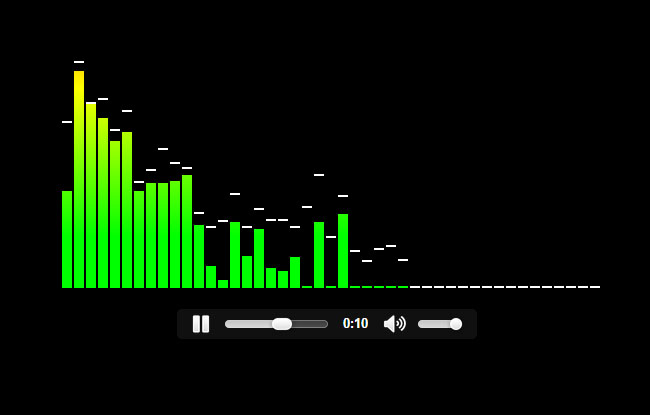通过HTML5实现音频可视化的频谱跳动,HTML5_Audio_Visualizer插件效果预览:
插件代码:
HTML代码:
<canvas id="canvas" width="800" height="350"></canvas> <br/> <audio src="yourmusic.mp3" id="audio" controls>audio element not supported</audio>
CSS代码:
body {background: #000; text-align: center; color: #fff;}
a{color:yellow;}
.bar-wrapper {height: 300px; position: relative;}
.bar {position: relative; bottom: 0; width: 5px; display: inline-block; border: 1px solid red; height: 5px; border-bottom: 3px solid #fff;}
Javascript代码:
/* *
* audio visualizer with html5 audio element
*
* v0.1.0
*
* licenced under the MIT license
*
* see my related repos:
* - HTML5_Audio_Visualizer https://github.com/wayou/HTML5_Audio_Visualizer
* - 3D_Audio_Spectrum_VIsualizer https://github.com/wayou/3D_Audio_Spectrum_VIsualizer
* - selected https://github.com/wayou/selected
* - MeowmeowPlayer https://github.com/wayou/MeowmeowPlayer
*
* reference: http://www.patrick-wied.at/blog/how-to-create-audio-visualizations-with-javascript-html
*/
window.AudioContext = window.AudioContext || window.webkitAudioContext || window.mozAudioContext;
window.onload = function() {
var audio = document.getElementById('audio');
var ctx = new AudioContext();
var analyser = ctx.createAnalyser();
var audioSrc = ctx.createMediaElementSource(audio);
// we have to connect the MediaElementSource with the analyser
audioSrc.connect(analyser);
analyser.connect(ctx.destination);
// we could configure the analyser: e.g. analyser.fftSize (for further infos read the spec)
// analyser.fftSize = 64;
// frequencyBinCount tells you how many values you'll receive from the analyser
var frequencyData = new Uint8Array(analyser.frequencyBinCount);
// we're ready to receive some data!
var canvas = document.getElementById('canvas'),
cwidth = canvas.width,
cheight = canvas.height - 2,
meterWidth = 10, //width of the meters in the spectrum
gap = 2, //gap between meters
capHeight = 2,
capStyle = '#fff',
meterNum = 800 / (10 + 2), //count of the meters
capYPositionArray = []; ////store the vertical position of hte caps for the preivous frame
ctx = canvas.getContext('2d'),
gradient = ctx.createLinearGradient(0, 0, 0, 300);
gradient.addColorStop(1, '#0f0');
gradient.addColorStop(0.5, '#ff0');
gradient.addColorStop(0, '#f00');
// loop
function renderFrame() {
var array = new Uint8Array(analyser.frequencyBinCount);
analyser.getByteFrequencyData(array);
var step = Math.round(array.length / meterNum); //sample limited data from the total array
ctx.clearRect(0, 0, cwidth, cheight);
for (var i = 0; i < meterNum; i++) {
var value = array[i * step];
if (capYPositionArray.length < Math.round(meterNum)) {
capYPositionArray.push(value);
};
ctx.fillStyle = capStyle;
//draw the cap, with transition effect
if (value < capYPositionArray[i]) {
ctx.fillRect(i * 12, cheight - (--capYPositionArray[i]), meterWidth, capHeight);
} else {
ctx.fillRect(i * 12, cheight - value, meterWidth, capHeight);
capYPositionArray[i] = value;
};
ctx.fillStyle = gradient; //set the filllStyle to gradient for a better look
ctx.fillRect(i * 12 /*meterWidth+gap*/ , cheight - value + capHeight, meterWidth, cheight); //the meter
}
requestAnimationFrame(renderFrame);
}
renderFrame();
audio.play();
}; 
